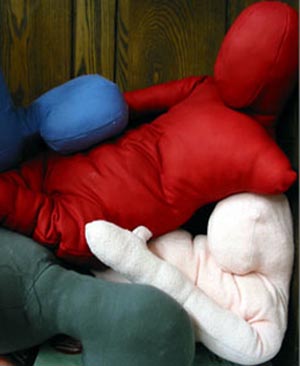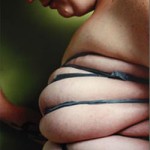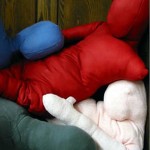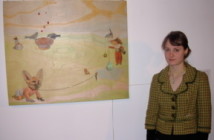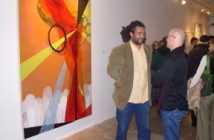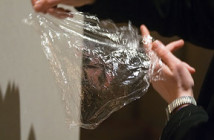Being semi-exposed is both daring and cautious. Like dipping one toe into a cold lake, it permits us to experiment safely. We take comfort in the knowledge that we never have to commit to complete, naked revelation, but is there harm in not just jumping blind? Can we fully experience life if we exist perpetually midway between one complete state and another? The current exhibition at Rhys Gallery owes much of its considerable success to its brave attempt to respond to those two questions. The show succeeds, not by providing answers, but by frankly and openly discussing the at once excruciating and comforting process of incomplete disclosure.
"Peeling Back the Curtain", curated by TT Baum and including works by Baum, Natalie Lachall and Zoe Sundra, earnestly examines lives lived in an in-between state of partial nudity. Addressing the overlaps of social, sexual, physical and emotional oddities, the show excels at avoiding the clichés that stain much work about these subjects. Baum deserves praise for his curatorial feat. He, Lachall, and Sundra also merit applause for their thoughtful, earnest and successful artworks.
Part of Baum’s success comes from choosing works that form a cohesive whole. In "Peeling Back the Curtain" the use of color serves as a sort of connective tissue binding the three installations. The color is bright and clear, unlike works in which edgy, garish colors heighten the sense of taboo and secrecy surrounding sexual abnormality. For example, in recent work by Mary Ellen Mark, her use of color comes uncomfortably close to imposing a narrative on her images of prostitutes in India; the gritty and ghoulish jade, sapphire and ruby tones write a story of forbidden pleasure, hidden lust and dank poverty; in using them Mark is duplicitous, hiding a moral code within documentary image. In this exhibit, on the other hand, all three artists use clear hues to create an environment of upbeat, sensory pleasure in which open and frank conversations about the grotesque, social norms, and subversion seem to happen without squeamishness and as a matter of course.
Baum’s Playroom is discomforting and inviting. From afar the installation has the nostalgic familiarity of a child’s room filled with brightly colored soft stuffed toys. Up close, however, the colorful shapes turn to be not teddy bears and dolls but disfigured, humanoid bodies and hanging plastic strap-on body parts. Once Baum enters as the character Toy Boy, he confirms our suspicions that this is not a child’s room but an adult’s. It's one man's surreal purgatory. Consistent with his choices as curator, Baum succeeds with Toy Boy by openly, and with a refreshing absence of rhetoric, presenting the complexities of a life stuck in an in-between space.
In Sideshow, Natalie Lachall, sits in her rocking chair and smiles as the four-legged Myrtle Corbin. Her friendly lack of self-consciousness regarding her evident deformity encourages people to sit down and speak with her, entering into lively, comfortable conversations. Tellingly, Lachall/Myrtle autographs photographs of herself with both her own and her character’s name: we have again entered the realm of transitional flux. Lachall does not presume to be Myrtle. Rather, by openly being both artist and character, Lachall lays bare the foundations of performance. She is what she is: an artist investigating the contemporary relevance of a life and moment long past; she is living in the in-between. Lachall’s unwillingness to become Myrtle may be due to an inexperience with performance however it works well. Peeling back curtains sometimes only reveals a stage.
As is true with all three performance pieces in this exhibition, Lachall makes the viewer an accomplice to the events that take place. By at once exploiting and honoring Myrtle and her colleagues, Lachall rightly places herself and her audience into the murky moral territory surrounding the commercialization and mainstream obsession with the abnormal. The audience participates in the sideshow, at once fascinated and disgusted by this charming four-legged girl. In this way, Sideshow becomes a clever comment on our consumptive culture that loves to be shocked and hates to be different.
Zoe Sundra’s complete submersion into her character Hostess, on the other hand, is fitting, for it, too, is honest. Livingroom, her minimally chromatic installation – just maroon, nude, black and white – serves as a window into the world of a unnamed, corseted woman obsessed with fleshy landscapes, oozing upholstery and rippling skin. Questions about body and beauty abound, but are conveyed with a humor that makes the viewer quite comfortable in this domestic scene of insecurity and even loneliness. Sundra’s willingness to laugh allows the viewer to relax and openly engage with topics so often discussed only tangentially and with shame.
Perhaps my favorite moment at the gallery was when Hostess wobbled around her living room alone, looking at her photographs and caressing the flesh rolling out of her corset. The moment was poignant, hilarious, and spot on. Hostess never seems comfortable talking with visitors to her living room; she won’t reveal on what trip she photographed the landscapes, nor her name, nor why everything, from her couches to her clothing to her fingernails, must match. We can witness, touch and experience all of Hostess’s idiosyncrasies, but we cannot know any more about them that what we see on the surface. We notice that the landscapes of rocky walls and mountainous fields unnervingly resemble the rolls of flesh bound and tied by the Hostess’s own clothing, but Hostess would never tolerate a question about the correlation. Therefore, watching her navigate her own space, unconsciously touching her stomach while glancing at a similarly seductive and voluptuous landscape, is the closest we will get to an answer.
Peeling Back the Curtain provides a refreshing experience in which three artists invested significant craft as well as thought in the work. It’s something viewers are not always confident of. These are young, thoughtful, talented artists who deserve high accolades. Colin Rhys also deserves praise for inviting TT Baum to curate this gem of a show.
Links:
Rhys Gallery
"Peeling Back the Curtain" ran through February 4th.
All images are courtesy of the artist and the Rhys Gallery.

